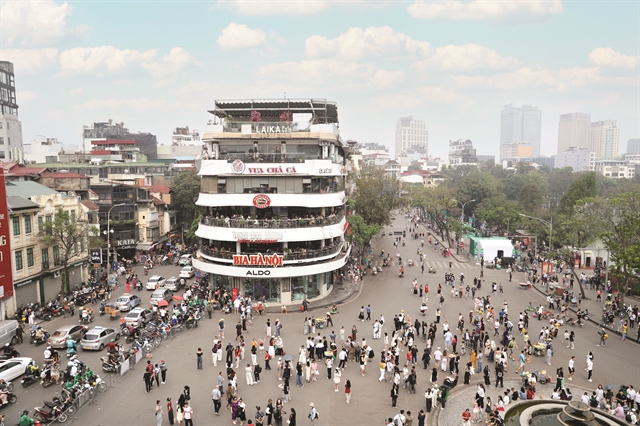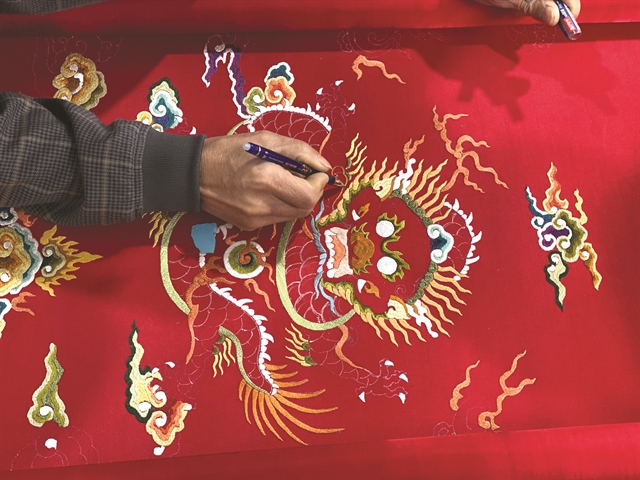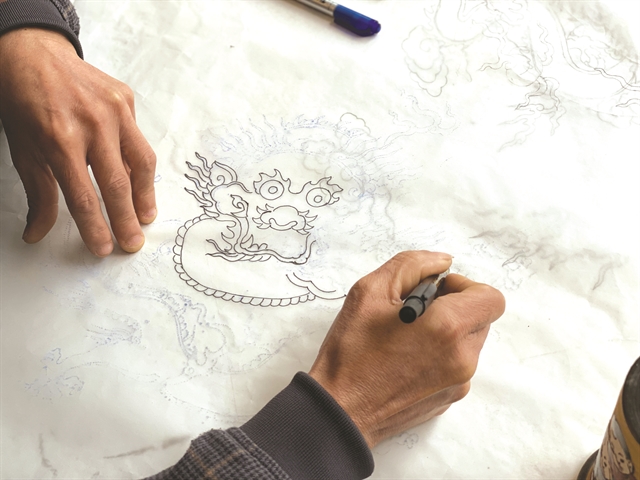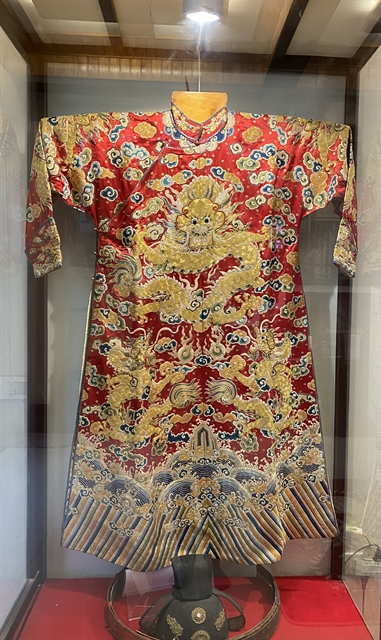 Sunday/Weekend
Sunday/Weekend

By Lê Hương
(*Additional research by Minh Phương)
Đông Cứu Village lies on the bank of the Nhuệ Giang River in Hà Nội’s suburban Thường Tín District, and has been long famed for its traditional embroidery.
Sticking true to its roots, the village worships Lê Công Hành (1606-1661), who received a royal doctorate degree under King Lê Thần Tông (1607-1662) and is the patron saint of this ancient craft.
It is said the mandarin taught villagers how to embroider royal parasols, which he had learnt on a business trip to China. The skill then were spread across many villages in the country.
Over time, Đông Cứu residents gradually specialised in making utensils and clothes for the royal family and the military.
The village is one of the very few places in the North offering exquisite 'royal clothes' in different styles of various Vietnamese royal dynasties. Some other villages maintain such profession, but their products are far less elegant and show inferior craftsmanship. Village elders say the local embroidery skills have been handed down through generations.
Nguyễn Thế Du, chairman of the Đông Cứu Village Embroidery Handicraft Association, says local workers' skills have distinguished features that are different from other areas in the region.
“The stitch should be made with twisted threads and blended finely with glittery threads,” he says.
“Only well-experienced artisans can combine the techniques to create exquisite patterns on cloth. The right mixture of colours can create a piece of beautiful embroidery, which highlights the high skill of the local artisans."
 |
| STITCH IN TIME: Royal costumes require stricter principles in embroidery. VNS Photo Lê Hương |
Among 50 households maintaining the ancient embroidery in the village, Vũ Văn Giỏi’s family specialises in making royal costumes.
“Royal costumes require stricter principles in embroidery,” he tells Việt Nam News. “There are symmetrical patterns in the cloth. In each single pattern, there are colours ranging from dark to light and multiple layers of thread to highlight the key patterns.”
Struggling path
Giỏi says that like many other handicraft villages, Đông Cứu has experienced more than its fair share of ups and downs over the years.
In 1991-98, the embroidery trade was on the up, with more and more customers coming to place order. An overseas Vietnamese came to order Giỏi to embroider costumes for a music band and some costumes for religious ceremonies. Then the customer ordered some royal costumes of the Nguyễn Dynasty.
“I agreed immediately, but then discovered that I had no models to follow,” he says.
 |
| STARTING OFF:Giỏi works on a sketch of patterns for embroidering. VNS Photo Lê Hương |
"I went to Bắc Ninh and Huế, read more historical books, and visited pagodas and temples to see decorative patterns at the heritage sites."
He and his wife started with a royal costume of the Nguyễn Dynasty, and then continued to research the royal costumes of the Đinh, Lý, Trần, Lê, and Trịnh dynasties.
Giỏi says the most difficult stage in remaking royal costumes is analysing costumes sizes.
The task requires consulting books and manuscripts by royal historians.
"Then, decorative patterns should be arranged to be well-balanced," he says.
“Each dynasty has some changes in design, decorative patterns, colours, and materials. Artisans should do serious research, as there have been almost no intact royal costumes available.”
Refined patterns
After marking out the design, the next step is choosing suitable cloth materials and thread for the opulent detailed costumes.
 |
| DETAILED: A king's robe of the Nguyễn Dynasty displayed in Giỏi's house. VNS Photo Lê Hương |
“I have come to some silk weaving villages like Vạn Phúc in Hà Nội and Nha Xá in Hà Nam Province to find the desired materials,” he says. “There are many kinds of cloth available, but not every kind can be used.”
During the embroidering process, unsuitable types of thread are eliminated. The artisan then came to other areas to learn how to dye thread in an organic way.
“King’s robes should be embroidered with a kind of thick thread, while those for queens' are thinner,” he says. “Different royal members will have coats with different decorative patterns, design and colours.”
Each pattern in a royal robe should be embroidered in different colours. For example, blue is used for waves. There are five different shades of blue in different clusters.
Each pattern should embody a meaning within feng shui or wishes to the king and other royal members.
Giỏi says royal costumes should be embroidered differently from modern way of embroidering.
"It may take a whole year, or even longer, to make a royal robe as it may need to be studded with pieces of precious metal and gems. Thousands of details should combine in a perfect way to create a unique work of art with great cultural value," he says.
Next generation
According to Du, embroidery looks leisured but in fact, it is hard and requires great care, patience and concentration.
 |
| Giỏi (left) passes embroidery skills to his eldest son. VNS Photo Minh Phương |
“Giỏi is the only artisan in the country succeeding in remaking royal costumes,” Du says.
Giỏi and his team have made dozens of pieces of royal costumes including robes for kings, queens, princesses and princes like the ones for King Đồng Khánh, Bảo Đại, Tự Đức and their family members.
The costumes are now exhibited in the Huế Museum of Royal Antiquities and some private collections overseas.
Thanks to his efforts, Giỏi was bestowed the title "Meritorious Artisan" in 2013 and "People’s Artisan" (the highest of its kind) in 2016.
“I have taught various high-skill training courses for local embroiderers in the village and neighbouring areas,” he says. “But I have limited time. In my family, I’m teaching my children to preserve the craft.”
Vũ Đình Thi, Giỏi’s eldest son, has little by little taken up the art.
“I have not learned the craft at any fine art course,” Thi says. “I have been influenced by my father since I was small. I have seen him sketching patterns and embroidering. Then gradually, he held my hand to draw. He taught me how to draw beautifully.”
 |
| FAMILY TRADITION: Young people rarely like the career as they prefer more active jobs. VNS Photo Minh Phương |
Thi says that young people like him in the village don’t like such kind of work, which is too detailed and requires much diligence. They prefer more active jobs.
“It took me three years to learn from my father before I could make my first product,” he says. “Young people should have a true love, a real passion for it and an awareness to maintain the craft.”
Thi is trying to learn more from his father to keep his family’s tradition, popularise the patterns and use them in more popular goods.
Giỏi says that only museums and collectors with real passion have ordered him to make such royal costumes, and that such costumes cannot be sold commercially or be mass-produced as they require much labour, time and special materials. VNS









